Hibiscus
From Wikipedia, the free encyclopedia
For other uses, see Hibiscus (disambiguation).
| Hibiscus | |
|---|---|
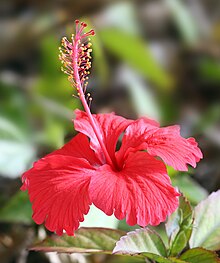 | |
| Hibiscus rosa-sinensis | |
| Scientific classification | |
| Kingdom: | Plantae |
| (unranked): | Angiosperms |
| (unranked): | Eudicots |
| (unranked): | Rosids |
| Order: | Malvales |
| Family: | Malvaceae |
| Subfamily: | Malvoideae |
| Tribe: | Hibisceae |
| Genus: | Hibiscus L. |
| Species | |
| Synonyms | |
Bombycidendron Zoll. & Moritzi Bombycodendron Hassk. Brockmania W.Fitzg. Pariti Adans. Wilhelminia Hochr.[1] | |
Hibiscus (/hɨˈbɪskəs/[2] or /haɪˈbɪskəs/[3]) is a genus of flowering plants in the mallow family, Malvaceae. It is quite large, containing several hundred species that are native to warm-temperate, subtropical andtropical regions throughout the world. Member species are often noted for their showy flowers and are commonly known simply as hibiscus, or less widely known as rose mallow. The genus includes both annual and perennial herbaceous plants, as well as woody shrubs and small trees. The generic name is derived from the Greek word ἱβίσκος (hibískos), which was the name Pedanius Dioscorides (ca. 40–90) gave to Althaea officinalis.[4]
Contents
[hide]Description[edit]
The leaves are alternate, ovate to lanceolate, often with a toothed or lobed margin. The flowers are large, conspicuous, trumpet-shaped, with five or more petals, color from white to pink, red, orange, purple or yellow, and from 4–18 cm broad. Flower color in certain species, such as H. mutabilis and H. tiliaceus, changes with age.[5] The fruit is a dry five-lobed capsule, containing several seeds in each lobe, which are released when the capsule dehisces(splits open) at maturity. It is of red and white colours. It is an example of complete flowers.
Uses[edit]
Symbolism and culture[edit]
The hibiscus is the national flower of Haiti and is used in their national tourism slogan of Haïti: Experience It![6][7] The Hibiscus species also represents several other nations. The Hibiscus syriacus is the national flower of South Korea, andHibiscus rosa-sinensis is the national flower ofMalaysia. The red hibiscus is the flower of theHindu goddess Kali, and appears frequently in depictions of her in the art of Bengal, India, often with the goddess and the flower merging in form. The hibiscus is used as an offering to goddess Kali and Lord Ganesha in Hindu worship.[citation needed] [8]
In the Philippines, the gumamela (local name for hibiscus) is used by children as part of a bubble-making pastime. The flowers and leaves are crushed until the sticky juices come out. Hollowpapaya stalks are then dipped into this and used as straws for blowing bubbles.
The hibiscus flower is traditionally worn by Tahitianand Hawaiian girls. If the flower is worn behind the left ear, the woman is married or in a relationship. If the flower is worn on the right, she is single or openly available for a relationship.[citation needed] The hibiscus is Hawaii's state flower.
Nigerian author Chimamanda Ngozi Adichie named her first novel Purple Hibiscus after the delicate flower.
The bark of the hibiscus contains strong bast fibresthat can be obtained by letting the stripped bark set in the sea to let the organic material rot away.
Landscaping[edit]
Many species are grown for their showy flowers or used as landscape shrubs, and are used to attract butterflies, bees, and hummingbirds.[9]
Paper[edit]
Beverage[edit]
Main article: Hibiscus tea
The tea made of hibiscus flowers is known by many names in many countries around the world and is served both hot and cold. The beverage is well known for its color, tanginess and flavor.
It is known as bissap in West Africa, "Gul e Khatmi" in Urdu & Persian, agua de jamaica in Mexico and Honduras (the flower being flor de jamaica) andgudhal (गुड़हल) in India. Some refer to it as roselle, a common name for the hibiscus flower. In Jamaica, Trinidad and many other islands in the Caribbean, the drink is known as sorrel (Hibiscus sabdariffa; not to be confused with Rumex acetosa, a species sharing the common name sorrel). In Ghana, the drink is known as soobolo in one of the local languages.
In Cambodia, a cold beverage can be prepared by first steeping the petals in hot water until the colors are leached from the petals, then adding lime juice (which turns the beverage from dark brown/red to a bright red), sweeteners (sugar/honey) and finally cold water/ice cubes.
In Egypt,[citation needed] Sudan and the Arab world, hibiscus tea is known askarkadé (كركديه), and is served as both a hot and a cold drink.
Food[edit]
Dried hibiscus is edible, and it is often a delicacy in Mexico. It can also be candied and used as a garnish.[10]
The roselle (Hibiscus sabdariffa) is used as a vegetable. The species Hibiscus suratensis Linn synonymous to Hibiscus aculeatus G. Don is noted in Visayas Philippines being a souring ingredient for almost all local vegetables and menus. Known as Labog in the Visayan area, (or Labuag/Sapinit in Tagalog), the species is a very good ingredient in cooking native chicken soup.
Hibiscus species are used as food plants by the larvae of some Lepidopteranspecies, including Chionodes hibiscella, Hypercompe hambletoni, the nutmeg moth, and the turnip moth.
Health benefits[edit]
The tea is popular as a natural diuretic; it containsvitamin C and minerals, and is used traditionally as a mild medicine.
A 2008 USDA study shows consuming hibiscus tea lowers blood pressure in a group of prehypertensiveand mildly hypertensive adults. Three cups of tea daily resulted in an average drop of 8.1 mmHg in their systolic blood pressure, compared to a 1.3 mmHg drop in the volunteers who drank the placebo beverage. Study participants with higher blood pressure readings (129 or above) had a greater response to hibiscus tea: their systolic blood pressure went down by 13.2 mmHg. These data support the idea that drinking hibiscus tea in an amount readily incorporated into the diet may play a role in controlling blood pressure, although more research is required.[11]
Studies have demonstrated the anti-hypertensive effects of H. sabdariffa in both humans and animals.[12] It has been proposed that the antihypertensive effects of H. sabdariffa is due to itsangiotensin-converting enzyme inhibiting activity.[13] In a randomized, controlled clinical trial involving 39 patients with mild to moderate hypertension, Captopril was compared to an extract of H. sabdariffa for antihypertensive effects. Subjects taking an extract of H.sabdariffa, consumed daily before breakfast for four weeks, found reduction in blood pressure similar to Captopril.[14] Another randomized, placebo clinical trial involving 54 study participants with moderate hypertension demonstrated a reduction in both systolic and diastolic blood pressure. However upon discontinuation of treatment, both systolic and diastolic blood pressures were subsequently elevated.[15]
Hibiscus rosa-sinensis has a number of medical uses in Chinese herbology.[16] Sidram A. et al. their research indicates some potential in cosmetic skin care; for example, an extract from the flowers of Hibiscus rosa- sinensis has been shown to function as an anti-solar agent by absorbingultraviolet radiation.[17]
In the Indian traditional system of medicine, Ayurveda, hibiscus, especially white hibiscus and red hibiscus (Hibiscus rosa-sinensis), is considered to have medicinal properties. The roots are used to make various concoctions believed to cure ailments such as cough, hair loss or hair greying. As a hair treatment, the flowers are boiled in oil along with other spices to make a medicated hair oil. The leaves and flowers are ground into a fine paste with a little water, and the resulting lathery paste is used as a shampoo plus conditioner.
Hibiscus tea also contains bioflavonoids, which are believed to help prevent an increase in LDL cholesterol, which can increase the buildup of plaque in the arteries.[18]
A previous animal study demonstrated the effects of H.sabdariffa extract onatherosclerosis in rabbits. Notably, a reduction in triglyceride, cholesterol, and low-density lipoprotein was observed in rabbits consuming a high cholesterol diet (HCD) in addition to H.sabdariffa extract compared to rabbits only fed HCD, suggesting a beneficial effect.[19] Furthermore, the H. sabdariffa seed is abundant in phytosterol and tocopherol, plant forms of cholesterol that have antioxidant and LDL cholesterol lowering effects.[20]
Precautions and contraindications[edit]
Pregnancy and lactation[edit]
While the mechanism is not well understood, previous animal studies have demonstrated both an inhibitory effect of H. sabdariffa on muscle tone and the anti-fertility effects of Hibiscus rosa-sinensis, respectively.[21][22] The extract of H. sabdariffa has been shown to stimulate contraction of the rat bladder and uterus;[21] the H.rosa-sinensis extract has exhibited contraceptive effects in the form of estrogen activity in rats.[22] These findings have not been observed in humans. The Hibiscus rosa-sinensis is also thought to have emmenagogue effects which can stimulatemenstruation and, in some women, cause an abortion.[23][24][25] Due to the documented adverse effects in animal studies and the reported pharmacological properties, the H. sabdariffa and H.rosa-sinensis are not recommended for use during pregnancy.[25] Additionally, they are not recommended while breastfeeding due to the lack of reliable information on its safety and use.
Contraindications[edit]
| This section is empty. You can help by adding to it. (April 2015) |
Adverse effects[edit]
Drug interactions[edit]
It is postulated that H. sabdariffa interacts with diclofenac, chloroquine andacetaminophen by altering the pharmacokinetics. In healthy human volunteers, the H. sabdariffa extract was found to reduce the excretion of diclofenac upon co-administration.[26] Additionally, co-administration of Karkade (H. sabdariffa), a common Sudanese beverage, was found to reduce chloroquine bioavailability.[27] However, no statistically significant changes were observed in the pharmacokinetics of acetaminophen when administered with the Zobo (H.sabdariffa) drink.[28] Further studies are needed to demonstrate clinical significance.
Species[edit]
In temperate zones, probably the most commonly grown ornamental species is Hibiscus syriacus, the common garden hibiscus, also known in some areas as the "Rose of Althea" or "Rose of Sharon" (but not to be confused with the unrelated Hypericum calycinum, also called "Rose of Sharon"). In tropical and subtropical areas, the Chinese hibiscus (H. rosa-sinensis), with its many showy hybrids, is the most popular hibiscus.
Several hundred species are known, including:
Formerly placed here[edit]
|
|



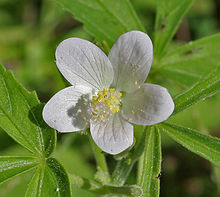
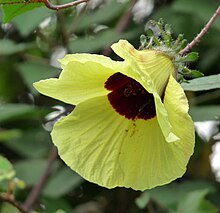




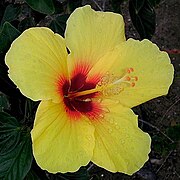


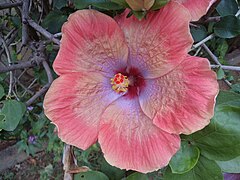




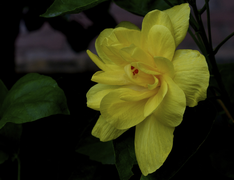
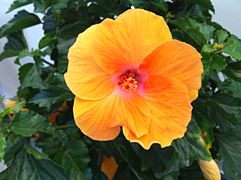
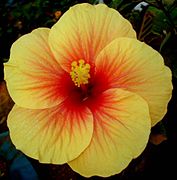

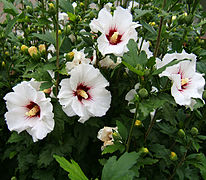


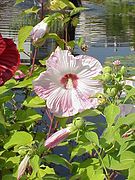











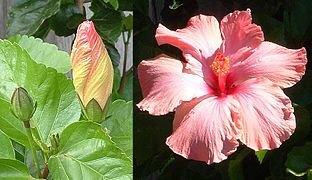
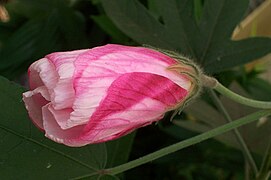

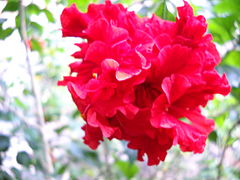
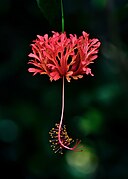


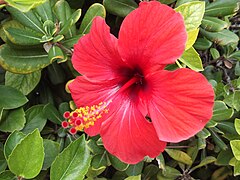


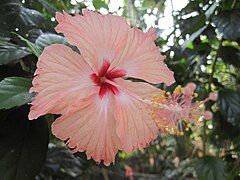

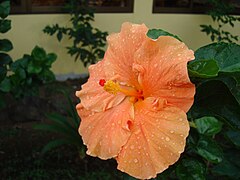


No comments:
Post a Comment